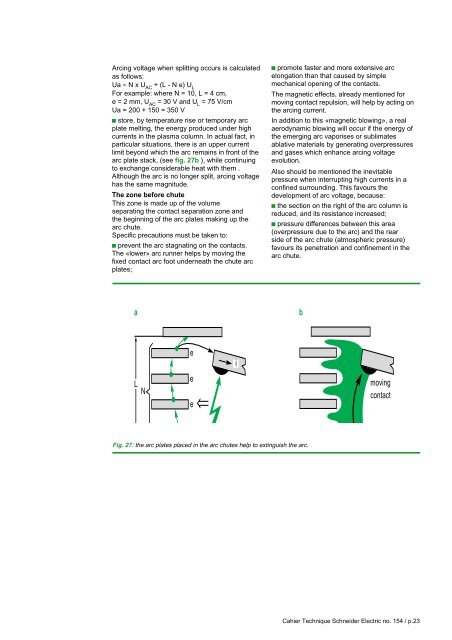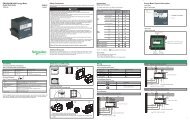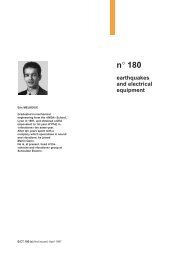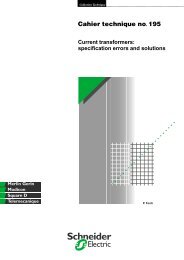Low Voltage circuit-breaker breaking techniques - Schneider Electric
Low Voltage circuit-breaker breaking techniques - Schneider Electric
Low Voltage circuit-breaker breaking techniques - Schneider Electric
- No tags were found...
Create successful ePaper yourself
Turn your PDF publications into a flip-book with our unique Google optimized e-Paper software.
⇒Arcing voltage when splitting occurs is calculatedas follows:Ua ≈ N x U AC+ (L - N e) U LFor example: where N = 10, L = 4 cm,e = 2 mm, U AC= 30 V and U L= 75 V/cmUa = 200 + 150 = 350 Vc store, by temperature rise or temporary arcplate melting, the energy produced under highcurrents in the plasma column. In actual fact, inparticular situations, there is an upper currentlimit beyond which the arc remains in front of thearc plate stack, (see fig. 27b ), while continuingto exchange considerable heat with them .Although the arc is no longer split, arcing voltagehas the same magnitude.The zone before chuteThis zone is made up of the volumeseparating the contact separation zone andthe beginning of the arc plates making up thearc chute.Specific precautions must be taken to:c prevent the arc stagnating on the contacts.The «lower» arc runner helps by moving thefixed contact arc foot underneath the chute arcplates;c promote faster and more extensive arcelongation than that caused by simplemechanical opening of the contacts.The magnetic effects, already mentioned formoving contact repulsion, will help by acting onthe arcing current.In addition to this «magnetic blowing», a realaerodynamic blowing will occur if the energy ofthe emerging arc vaporises or sublimatesablative materials by generating overpressuresand gases which enhance arcing voltageevolution.Also should be mentioned the inevitablepressure when interrupting high currents in aconfined surrounding. This favours thedevelopment of arc voltage, because:c the section on the right of the arc column isreduced, and its resistance increased;c pressure differences between this area(overpressure due to the arc) and the rearside of the arc chute (atmospheric pressure)favours its penetration and confinement in thearc chute.abeiL NeemovingcontactFig. 27: the arc plates placed in the arc chutes help to extinguish the arc.Cahier Technique <strong>Schneider</strong> <strong>Electric</strong> no. 154 / p.23
















